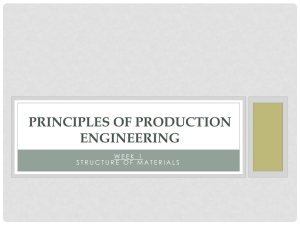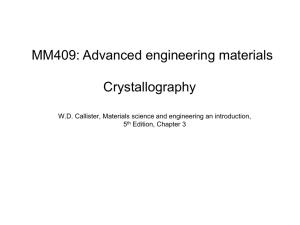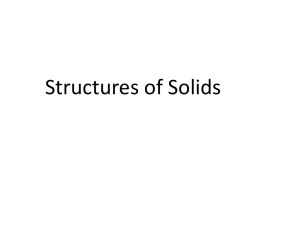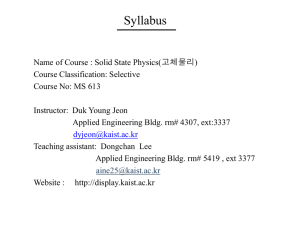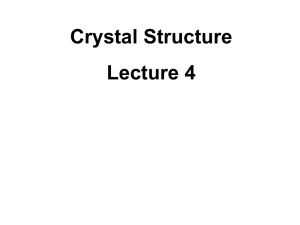ppt
advertisement
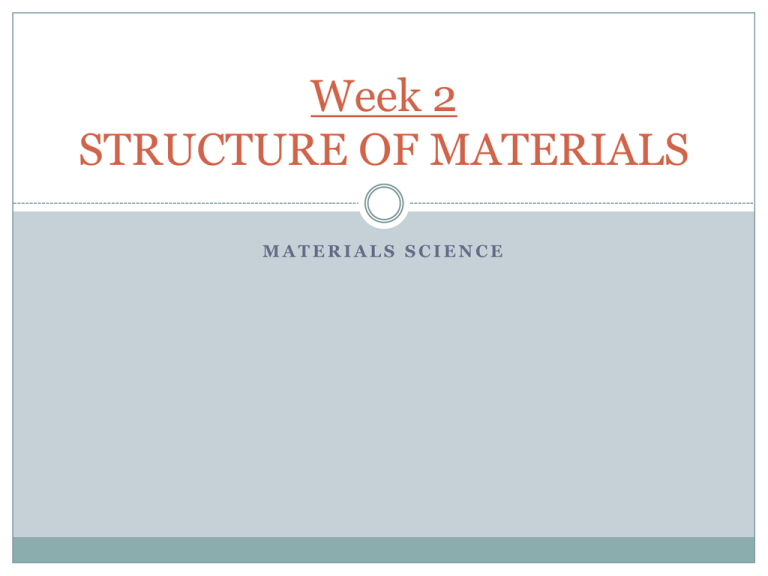
Week 2 STRUCTURE OF MATERIALS MATERIALS SCIENCE Why Study Crystal Structure of Materials? The properties of some materials are directly related to their crystal structures Significant property differences exist between crystalline and noncrystalline materials having the same composition Crystalline and Crystal Structure A crystalline material is one in which the atoms are situated in a repeating or periodic array over large atomic distances All metals, many ceramics, and some polymers make crystalline structure Some of the properties of crystalline solids depend on the crystal structure of the material Lattice In crystalline structures, atoms are considered as being solid spheres having well-defined diameters Atomic hard sphere model -> in which spheres representing nearest-neighbor atoms touch one another Lattice is a regularly spaced array of points that represents the structure of a crystal Unit Cells Unit Cell is the smallest group of atoms or molecules whose repetition at regular intervals in three dimensions produces the lattices of a crystal They are parallelepipeds or prisms having three sets of parallel faces A unit cell is chosen to represent the symmetry of the crystal structure Metallic Crystal Structures 1. The Face-Centered Cubic Crystal Structure 2. The Body-Centered Cubic Crystal Structure 3. The Hexagonal Close-Packed Crystal Structure Face-Centered Cubic Structure (FCC) FCC -> a unit cell of cubic geometry, with atoms located at each of the corners and the centers of all the cube faces For the fcc crystal structure, each corner atom is shared among eight unit cells, whereas a facecentered atom belongs to only two Therefore, one-eighth of each of the eight corner atoms and one-half of each of the six face atoms, or a total of four whole atoms, may be assigned to a given unit cell copper, aluminum, silver, and gold have fcc The cell comprises the volume of the cube, which is generated from the centers of the corner atoms FCC - Exercise Derive: Where a = side length of the unit cell cube And R = Radius of the atom sphere FCC – Coordination Number and APF For metals, each atom has the same number of touching atoms, which is the coordination number For fcc, coordination number is 12 The APF (Atomic Packing Factor) is the sum of the sphere volumes of all atoms within a unit cell divided by the unit cell volume For fcc, APF is 0.74 Body-Centered Cubic Structure (BCC) BCC -> a cubic unit cell with atoms located at all eight corners and a single atom at the cube center Center and corner atoms touch one another along cube diagonals BCC - Exercise Derive: Where a = side length of the unit cell cube And R = Radius of the atom sphere BCC Chromium, iron, tungsten exhibit bcc structure Two atoms are associated with each BCC unit cell The coordination number for the BCC is 8 the atomic packing factor for BCC lower—0.68 versus 0.74 (FCC) Packing Factor – FCC vs BCC Hexagonal Close-Packed Crystal (HCP) The top and bottom faces of the unit cell consist of 6 atoms that form regular hexagons and surround a single atom in the center Another plane that provides 3 additional atoms to the unit cell is situated between the top and bottom planes The atoms in this mid-plane have as nearest neighbors atoms in both of the adjacent two planes Hexagonal Close-Packed Crystal (HCP) The equivalent of six atoms is contained in each unit cell If a and c represent, respectively, the short and long unit cell dimensions the c/a ratio should be 1.633 The coordination number and the APF for the HCP are the same as for FCC: 12 and 0.74, respectively The HCP metals include cadmium, magnesium, titanium, and zinc, etc Density Computations Density of a material can be computed from its crystalline structure n = number of atoms associated with each unit cell A = atomic weight VC = volume of the unit cell NA = Avogadro’s number (6.023 X 1023 atoms/mol) EXAMPLE PROBLEM 3.3 Copper has an atomic radius of 0.128 nm, an FCC crystal structure, and an atomic weight of 63.5g/mol. Compute its theoretical density and compare the answer with its measured density Solution: The crystal structure is FCC, n = 4 ACu = 63.5g/mol VC = a3 = [2R(2)1/2]3 (For FCC)= 16R3(2)1/2 ; R (atomic radius) = 0.128nm Using the equation: EXAMPLE PROBLEM 3. The literature value for density for Cu is 8.94g/cm3 Crystallographic Points, Planes, and Directions It becomes necessary to specify a particular point within a unit cell, a crystallographic direction, or some crystallographic plane of atoms. A right-handed coordinate system consisting of three (x, y, and z) axes situated at one of the corners and coinciding with the unit cell edges 1. POINT COORDINATES The position of any point located within a unit cell may be specified in terms of its coordinates as fractional multiples of the unit cell edge lengths (i.e., in terms of a, b, and c). Thus, the position of P is designated using coordinates q r s with values that are less than or equal to unity EXAMPLE PROBLEM 3.4 For the unit cell shown in the accompanying sketch, locate the point having coordinates 1/4 1 ½ Do EXAMPLE PROBLEM 3.5 by yourself 2. CRYSTALLOGRAPHIC DIRECTIONS A crystallographic direction is defined as a line between two points, or a vector A vector of convenient length is positioned such that it passes through the origin of the coordinate system 2. The length of the vector projection on each of the three axes is determined 3. These three numbers are multiplied or divided by a common factor to reduce them to the smallest integer values 4. The three indices are enclosed in square brackets, thus: [uvw]. 1. 2. CRYSTALLOGRAPHIC DIRECTIONS The [100], [110], and [111] directions within a unit cell the [ 1Ī1] direction would have a component in –Y the direction Changing the signs of all indices produces an antiparallel direction EXAMPLE PROBLEM 3.6 Determine the indices for the direction shown in the figure Projections of this vector onto the x, y, and z axes are, respectively, a/2, b, and 0c, which become ½, 1, and 0 in terms of the unit cell parameters Multiply by 2 We get [120] Example Problem 3.6 (Do by yourself) 2. CRYSTALLOGRAPHIC DIRECTIONS For some crystal structures, several nonparallel directions with different indices are actually equivalent For example, in cubic crystals, all the directions represented by the following indices are equivalent Equivalent directions are grouped together into a family, which are enclosed in angle brackets, thus: <100> 3. CRYSTALLOGRAPHIC PLANES In all but the hexagonal crystal system, crystallographic planes are specified by three Miller indices as (hkl). Any two planes parallel to each other are equivalent and have identical indices 1. If the plane passes through the selected origin, either another parallel plane must be constructed within the unit cell by an appropriate translation, or a new origin must be established at the corner of another unit cell 3. CRYSTALLOGRAPHIC PLANES The length of the planar intercept for each axis is determined in terms of the lattice parameters a, b, and c. 3. The reciprocals of these numbers are taken. A plane that parallels an axis may be considered to have an infinite intercept, and, therefore, a zero index. 2. 3. CRYSTALLOGRAPHIC PLANES 4. If necessary, these three numbers are changed to the set of smallest integers by multiplication or division by a common factor 5. Finally, the integer indices, not separated by commas, are enclosed within parentheses, thus: (hkl). For cubic crystals the planes and directions having the same indices are perpendicular to one another EXAMPLE PROBLEM 3.9 Determine the Miller indices for the plane shown in the sketch A new origin must be chosen at the corner of an adjacent unit cell, taken as Ó. This plane is parallel to the x axis, and the intercept may be taken as ∞a The y and z axes intersections, referenced to the new origin Ó are -b and c/2, respectively EXAMPLE PROBLEM 3.9 Thus, in terms of the lattice parameters a, b, and c, these intersections are ∞, -1, and ½ The reciprocals of these numbers are 0, -1, and 2 => (0ī2) Example Problem 3.6 (Do by yourself) Crystalline and Non Crystalline Materials 1. Single Crystal 2. Polycrystalline Materials 3. Anisotropy 1. Single Crystal For a crystalline solid, when the repeated arrangement of atoms is perfect or extends throughout the entirety of the specimen without interruption, the result is a single crystal If the extremities of a single crystal are permitted to grow without any external constraint, the crystal will assume a regular geometric shape having flat faces Within the past few years, single crystals have become extremely important in many of our modern technologies. 2. Polycrystalline Materials Most crystalline solids are composed of a collection of many small crystals or grains; such materials are termed polycrystalline Initially, small crystals or nuclei form at various positions. These have random crystallographic orientations 2. Polycrystalline Materials Growth of the crystallites; the obstruction of some grains that are adjacent to one another Upon completion of solidification, grains having irregular shapes have formed The grain structure as it would appear under the microscope; dark lines are the grain boundaries there exists some atomic mismatch within the region where two grains meet; this area, called a grain boundary 3. Anisotropy The physical properties of single crystals of some substances depend on the crystallographic direction in which measurements are taken This directionality of properties is termed anisotropy The extent and magnitude of anisotropic effects in crystalline materials are functions of the symmetry of the crystal structure 3. Anisotropy For many polycrystalline materials, the crystallographic orientations of the individual grains are totally random. Under these circumstances, even though each grain may be anisotropic, a specimen composed of the grain aggregate behaves isotropically Sometimes the grains in polycrystalline materials have a preferential crystallographic orientation, in which case the material is said to have a “texture.” 3. Anisotropy The magnetic properties of some iron alloys used in transformer cores are anisotropic—that is, grains (or single crystals) magnetize in a <100>type direction easier than any other crystallographic direction Energy losses in transformer cores are minimized by utilizing polycrystalline sheets of these alloys into which have been introduced a “magnetic texture” Numerical Problems Problems 3.2 to 3.19, 3.23 to 3.25, 3.27 to 3.32, and 3.37 to 3.43

